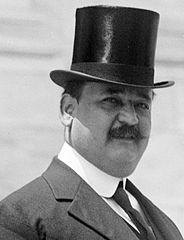Alfonso Quiñónez Molina
 zdjęcie z maja 1915 | |
| Data i miejsce urodzenia | 11 stycznia 1874 |
|---|---|
| Data śmierci | |
| Prezydent Salwadoru (samozwańczy) | |
| Okres | od 29 sierpnia 1914 |
| Poprzednik | Carlos Meléndez (samozwańczo) |
| Następca | |
| Prezydent Salwadoru (tymczasowy) | |
| Okres | od 21 grudnia 1918 |
| Poprzednik | |
| Następca | |
| Prezydent Salwadoru | |
| Okres | |
| Poprzednik | |
| Następca | |
Alfonso Quiñónez Molina (ur. 11 stycznia 1874, zm. 22 maja 1950) – był prezydentem Salwadoru w trzech okresach: 1914-1915, 1918-1919 oraz 1923-1927. Był ponadto wiceprezydentem w rządzie Jorge Meléndeza.
Należał do klasy konserwatywnej oligarchii plantatorów. Ożenek z siostrą braci Carlosa i Jorge Melendezów umożliwił mu udział w znacznych wpływach politycznych w Salwadorze.
Bibliografia
Media użyte na tej stronie
Coat of arms of El Salvador
- The coat of arms has the words (REPÚBLICA DE EL SALVADOR EN LA AMÉRICA CENTRAL) in a bold and Heavy, Sans Serif Boris Black Bloxx typeface, in a golden amber color
- The nacional motto (DIOS UNIÓN LIBERTAD) in bold version of Trajan (typeface), Roman type, Roman square capitals. The letters are colored black within a golden amber scroll.
- The date (15 DE SEPTIEMBRE DE 1821) in bold version of Trajan (typeface), Roman type, Roman square capitals.
President of El Salvador Alfonso Quiñónez Molina (1874-1950)


